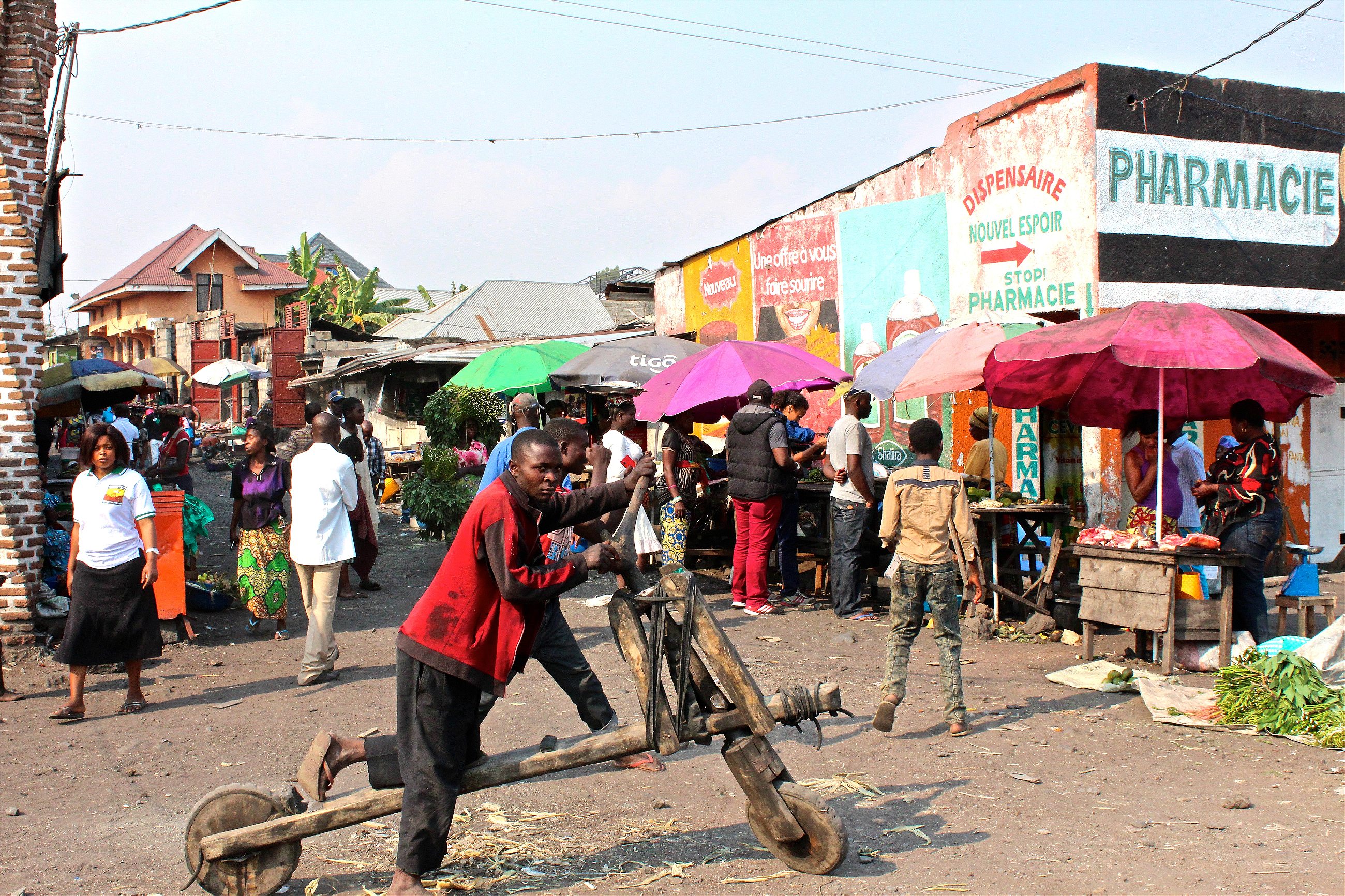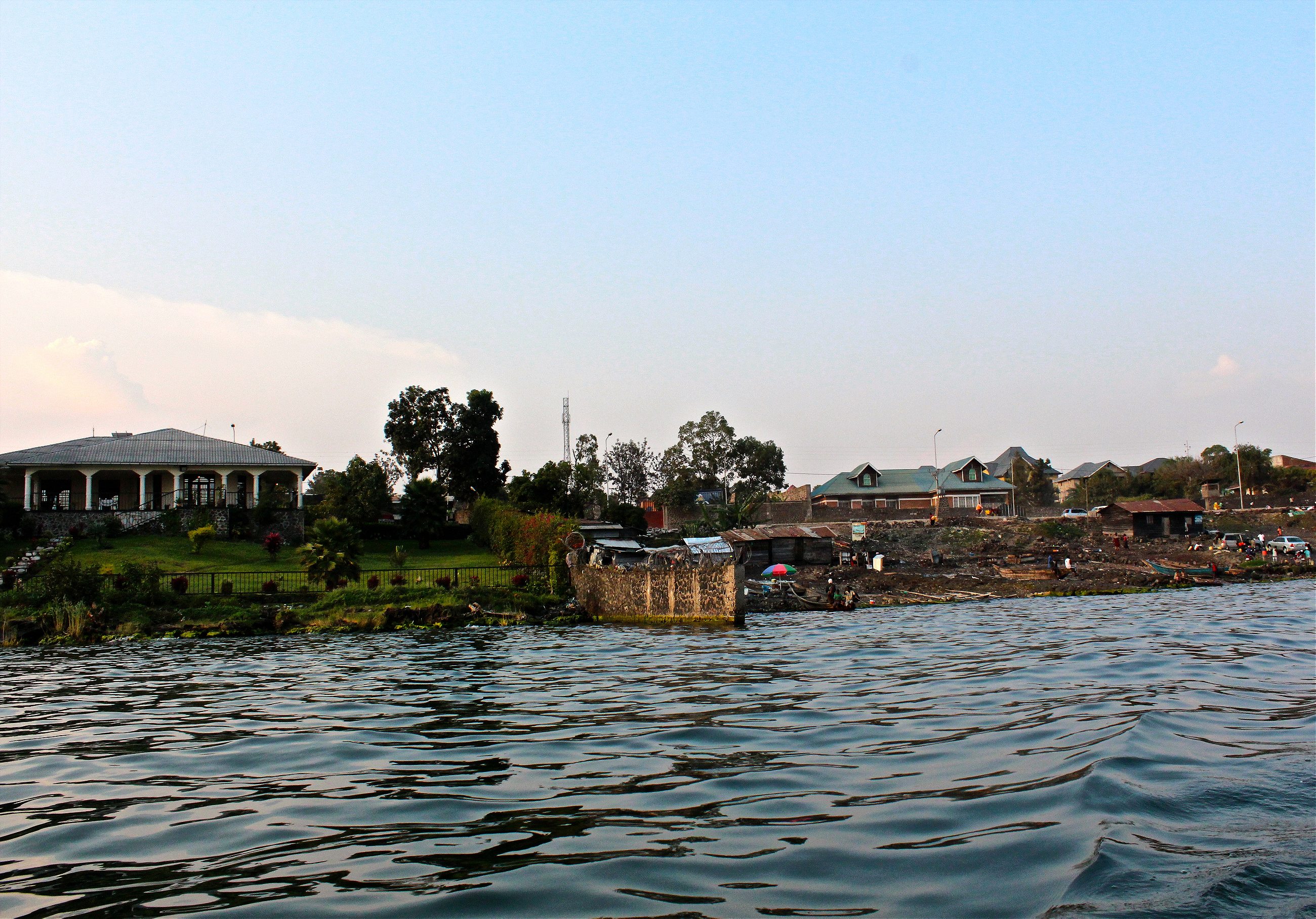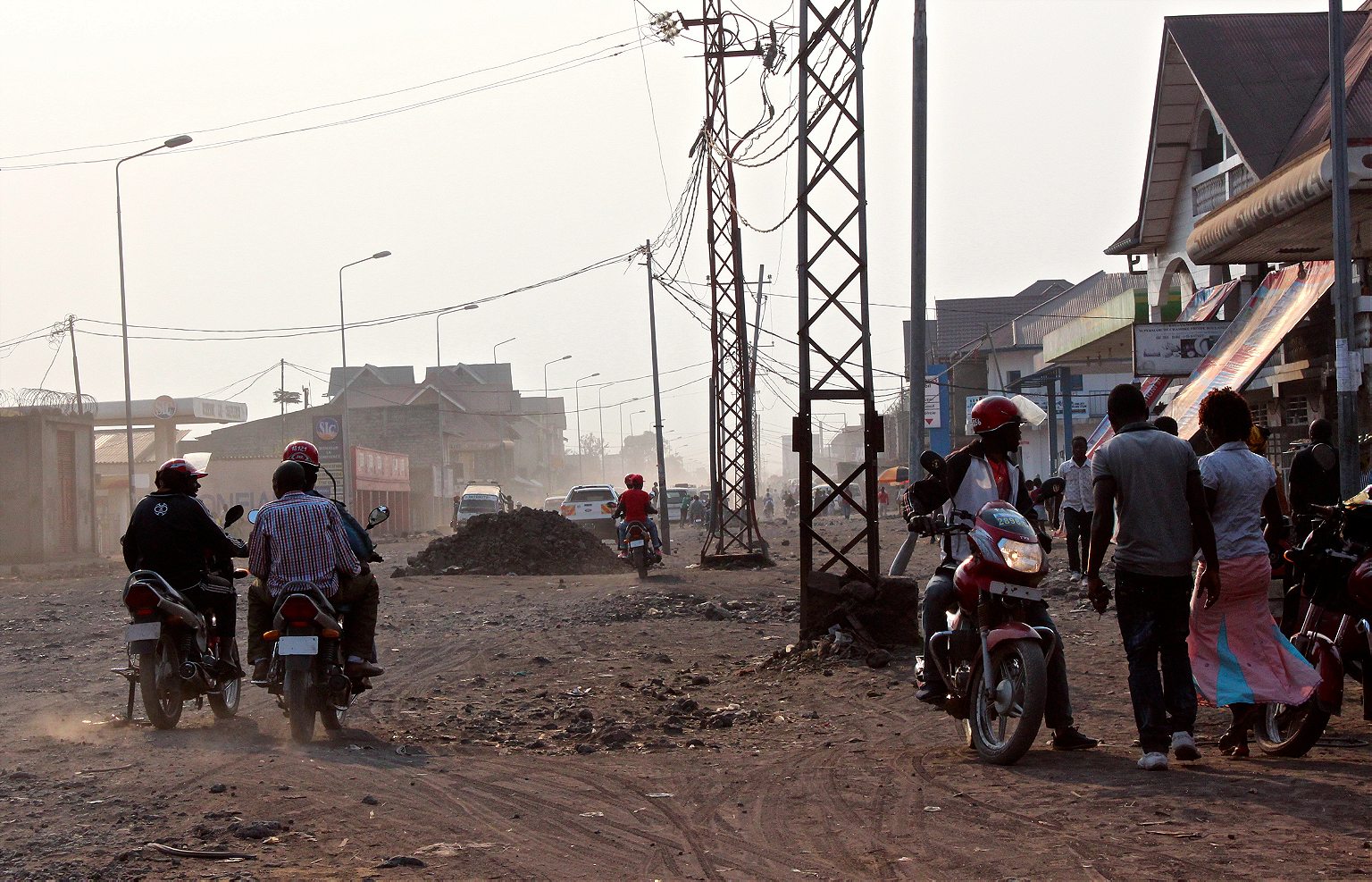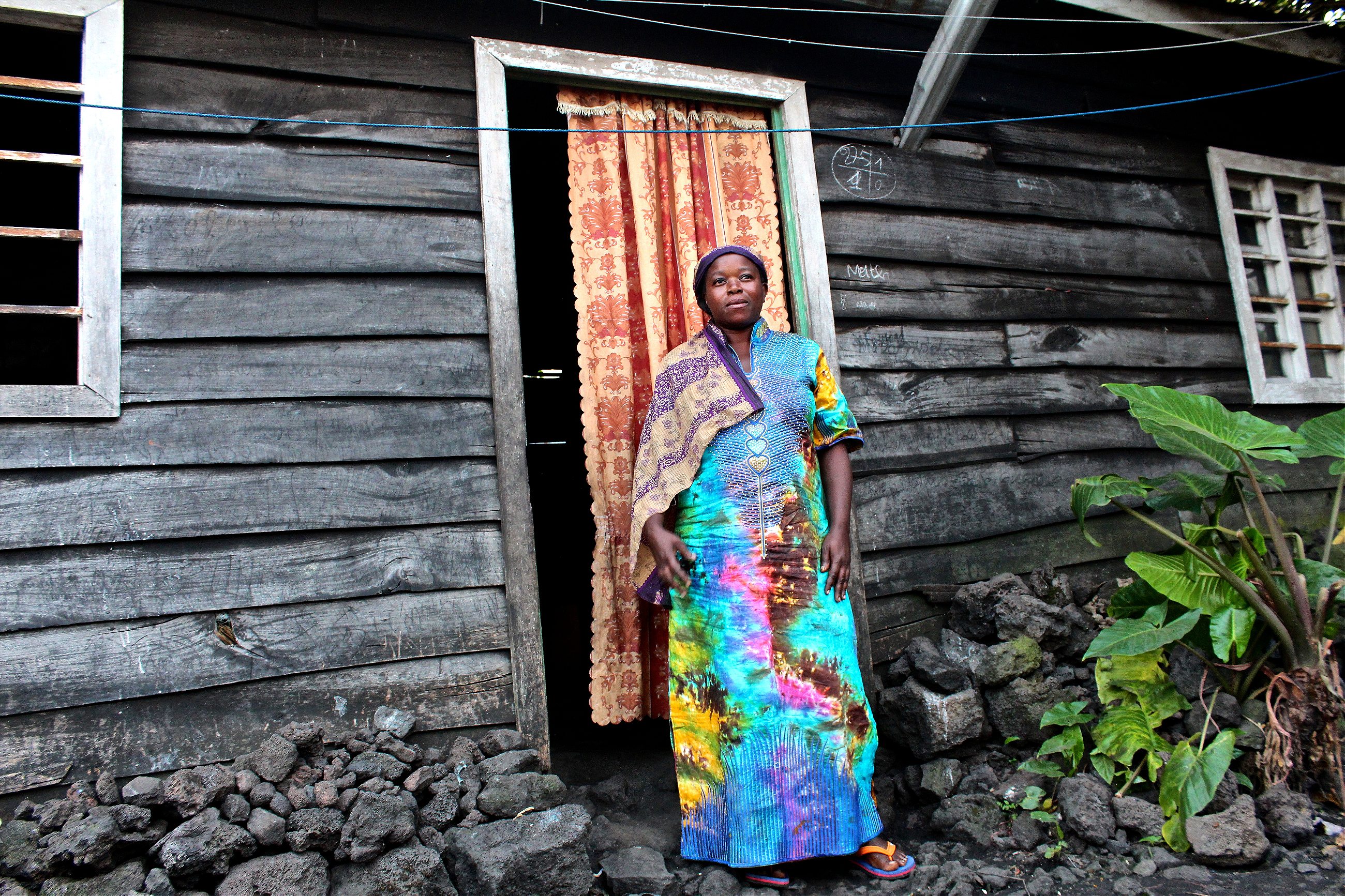How arms trading, corruption, illegal mining—and the foreign aid that comes with conflict—fuels a Congolese city’s boom.
Bishweka Vanny twirled a coin between two pens on his sparse desk as he proudly retold how he rose from rags to riches to build his dream: the Ihusi Hotel, a flashy red roofed property with a pool, a gym, and a lakefront view.
Vanny, who is short and bald with a wide nose, is one of the “Big Men” of Goma, the humanitarian hub of the Democratic Republic of Congo’s war-stricken east. These days, much of the city is connected to him in some way, from the roads, gas stations, and buildings he’s built, to the fast ferries he runs along Lake Kivu, to Goma’s green and clean chukudu roundabout, named for the two-wheeled wooden cart common in eastern Congo. Despite his prominence, he rarely speaks to the press and, as the dynamic often goes in Goma, only agreed to speak with me because I was a foreign (and female) journalist.
Vanny is best known as the owner of the Ihusi, one of a few upscale hotels in Goma serving the thriving NGO and business communities for around $100 and upwards a night. Goma is the capital of eastern Congo’s tumultuous North Kivu province, today a relatively safe area compared to previous, decades where hundreds of NGOs and aid organizations have settled as their base. And business is booming: property values are soaring, the number of paved roads is rising, and there’s even a café baking fresh croissants. Goma’s successes defy the tired war-torn-Africa narrative.
Conflict has become perversely good for Goma’s economy
But the city’s growth has also been incredibly uneven, with many average Congolese barely benefiting at all. Take a boat ride along Lake Kivu dividing Rwanda and Congo and the contrasts could not be starker: the shore is lined with large, walled off villas housing a who’s who of Congolese businessmen, NGOs, and United Nations programs—and just a pocket of land for people to fill their yellow jerry cans from the lake in the absence of running water for the masses.
The huge gap between rich and poor has been exacerbated by decades of war, and critics say conflict has become perversely good for Goma’s economy: it keeps the aid money flowing; arms contracts going; illegal mining and trading with rebels thriving; state neglect and corruption intact; and NGO budgets justified. Along the way, the divide between the Haves and Have Nots has cut deep, as money flows into real estate that consultants working to end the conflict rent for hundreds of U.S. dollars a month, while a few bumpy roads away Congolese struggle to find land they can afford.

While Vanny’s is a story of new money thriving, hotel owner Victor Ngezayo is more a remnant of the old. Ngezayo is another of Goma’s big businessmen, a coveted pack who made money through a mix of mining, transport, cement, petroleum, real estate, hotels, and complex webs of political connections. Ngezayo’s family name belongs to Goma and North Kivu province’s old Tutsi political elite. A healthy-looking 73-year-old with a pen in his shirt pocket, he’s lived a quarter century longer than the average Congolese male. Among other holdings, Ngezayo owns Hotel Karibu, a beautifully green complex with 100-rooms luxuriously nestled along Lake Kivu.
The hotel, he tells me, has had its share of struggles in the years before Goma’s boom, chief of all the instability that scared off tourists and rocked his families’ businesses, all while enabling the likes of Vanny to find ways to rise.
Ngezayo was born to a Congolese mother and Belgian father in 1943, back when Goma was a quiet resort town for Europeans. Then in 1960 Congo “received” independence from Belgium and five years later the notoriously corrupt Mobutu Sese Seko seized power. That same year Ngezayo registered as an entrepreneur: foreigners were leaving and he sensed opportunities.
After a series of transportation, farming, and coffee ventures, Ngezayo began to build Hotel Karibu in 1974. Goma, at that time, was “paradise,” he recalled. Ngezayo envisioned the hotel as part of a tourism-promoting enterprise to connect Congo’s famed Virunga Mountains, neighboring Rwanda, and beyond.

Instead came the 1994 Rwandan genocide and millions of Rwandan refugees, including fleeing rebels, who poured across the border into Goma. By 1996 war raged as Laurent Kabila ousted Mobutu. Soon the mineral-rich east was awash in an alphabet soup of local and proxy militias, as waves of fighting killed, displaced, and wounded millions of people. Hunger and disease were rampant.
By 2001 Kabila was murdered and his son, Joseph, took the reins. A year later Mount Nyiragongo erupted, covering a quarter of the city in lava. Goma rebuilt anyway. Peace agreements settled as rebel groups with names like the National Congress for the Defense of the People forced Congolese to flee to Goma and displaced people’s camps nearby. In 2013, M23 rebels briefly seized Goma, much to the government’s disgrace.
Hotel Karibu was once at the city’s outskirts, outside the security zone that houses most foreigners. In the last two decades Goma has grown from around 200,000 to an estimated two million people. In the city’s artificial economy, Ngezayo lamented, Hotel Karibu’s kinds of clients—like businessmen and humanitarians—can also all afford to stay because conflict is continuing. Now the hotel is known as a place to visit to see a remnant of the Goma of before.
Around Goma today there are stark reminders of what war both destroys and preserves. Past Hotel Karibu there’s the Governor’s house, an old Mobutu mansion, and a hotel in the works, reportedly belonging to the Minister of Culture. Keep driving and roads change fast from new pavement to rugged volcanic rock. This is also a huge improvement: the smooth roads and roundabouts are among Goma’s most lauded developments, made possible by funders like Vanny and the European Union. Still, the nicest road of all leads to the presidential compound, blocked off by huge concrete walls. Only when the compound ends so does the road, regressing into a trail of jagged dirt.
Nearby is the United Nations Organizations Stabilization Mission in Congo (MONUSCO) base, a billions-of-dollars peacekeeping effort. Along with MONUSCO, there are around 100 international humanitarian and development organizations that work around the east based in Goma. Then there’s Goma University, one of Congo’s top institutes. Windows are also likely smashed, a taste of how police respond to student protests. Carry on towards the port, past the expensive lakeside villas, and the road is suddenly packed with people hawking food and whatever while agents from the intelligence agency lurk. No pictures allowed.

Vanny was born poor in Birere, Goma’s commercial heart. Now the street outside his office (lined with buildings he owns) is named in his honor. On a wall inside hangs a photo of him meeting with Kabila.
Vanny’s story, as he tells it, is one of an upstart, hustling entrepreneur in times of turmoil. He was the first black man in Goma to own a mango stall and rose through the transport industry: he started off small, owning two of the city’s six motorbikes, and built up trade with nearby cities and Rwanda.
In 1992, Vanny started building Ihusi hotel, named after his father’s village in neighboring South Kivu. Then troubles came to Goma in 1994, so he stopped. He started and stopped again every few years, until fully completing Ihusi in 2001, including a tennis court, a swimming pool, and conference center. Soon after the volcano erupted.
Now Vanny is building a second Hotel Ihusi in Goma. He isn’t worried about a real estate bubble here. He’s purchased property next to MONUSCO, assuming it’s some of the safest. The president’s family even co-finances some of his ventures, a Congo researcher who asked to remain anonymous to protect their work explained.
“In five years, Goma can be the second best city in the DRC,” Vanny insisted. “Goma people have that mentality.”
Others worry the system is stacked against the people: that if conflict ends, so will the real estate sector and value invested in land.
“Rents in a place like Goma are not value neutral,” argued David Peyton, a researcher specializing in this issue. “It’s very politically connected and has deep political implications.”
The aid industry naturally remains a perennially contentious issue. The government intensely relies on it—and is quick to criticize costs and the problems showcased.
“NGOs should teach people to fish, not just give them fish,” Vanny told me twice during our interview.
“When the NGOs leave is the time that the Congolese will start walking on their feet,” Ngezayo insisted.

Hotels like Ihusi and Karibu—or the similarly classed Lake Kivu Lodge, owned by a Belgium businessman, where I stayed in Goma—also thrive off the foreigners who come for the seclusion and services afforded, from the Italian food to the expensive drinks to the privacy for a political or personal chat. And in other cases it can get darkly complicated. In Bukavu, also in the east, a recent AFP report found aid workers were renting from a businessman openly affiliated with rebels on a UN sanctions list.
These days, however, Ngezayo said he’s living day-to-day like all Congolese facing an unstable future. Uncertainty notwithstanding, Ngezayo’s lifestyle is far from the less-than-one-dollar-a-day reality for many Congolese.
Still, while Vanny has good relations with Kabila—the president, who has greatly enriched his pockets at the expense of the masses, has many friends of convenience—nowadays Ngezayo is more of a critic outside the government elite. And now across Congo tensions are rising as Kabila’s constitutional terms come to an end and his crew moves to delay a presidential election, raising the prospect of a resurgence of widespread violence.
It’s all speculation what this could mean for Goma’s humanitarian corridor. But it doesn’t bode well for the less affluent parts of Goma, like the neighborhood that Kavira Ngesera calls home. Ngesera is a hardworking and soft-spoken 41-year-old mother of eight who built her wooden home in 2000 after seven years of saving. Her husband, John, works as a driver, including for the foundation that funded my reporting trip.

Ngesera is native to Goma but fled three times for her family’s village nearby: when the Rwandans poured in, when the volcano erupted, and when M23 rebels invaded.
Now the dark grey-black of volcanic rock covers much of Ngesera’s neighborhood, peppered with the shine of tin roofs and the bright colors favored in Congolese style. In these neighborhoods aid and international projects haven’t fixed the roads or brought running water. They have helped households of people they employ, Ngesera explained—but not the rest.
Ngesera’s grateful for the home she has: for those who don’t already own land, money has become “a nightmare.” Still, she longs to move elsewhere. The dream? Goma’s posh Himbi quarter, near the lakefront and hotels.
Reporting for this story was supported by the International Women’s Media Foundation.